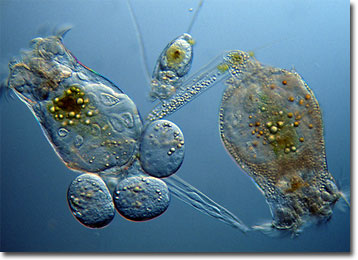Wim van Egmond
Brachionus Parasite
Brachionus is a genus of rotifers that reside in a variety of habitats, but are perhaps most often found in hard water lakes. The tiny animals, which only grow about 300 micrometers long, are encased in transparent shells called loricas.

As rotifers, Brachionus organisms feature ciliated coronas that appear similar to turning wheels when they are in motion. Individuals are also equipped with specialized organ systems, a fully formed digestive tract, and a foot that contains pedal glands. Sticky secretions produced by the glands enable the rotifers to temporarily attach to substrates. Sometimes, once they are anchored to a surface, the organisms will release a length of filament and will locate themselves at the end of it with their hairlike cilia extended for feeding. The shells of Brachionus species and other loricate rotifers are primarily protective structures and may be variously ornamented, sometimes exhibiting spines or other protrusions. In fact, examination of lorica markings is often extremely helpful in species identification.
Despite their miniscule dimensions, the rotifers in the genus Brachionus have found a notable use in modern society. Often considered the most important living prey of fish larvae, the diminutive animals are heavily utilized in aquaculture. Their high nutritional value and ease of cultivation have inspired numerous hatchery managers to ensure their continual production. Their importance is further emphasized by the numerous studies that have been carried out to determine the protocols that most greatly contribute to high densities of rotifer populations. Brachionus species are, however, sometimes alternatively utilized as bioassay organisms or pollution indicators, rather than as a link in the commercial food chain.
BACK TO WIM VAN EGMOND GALLERY
